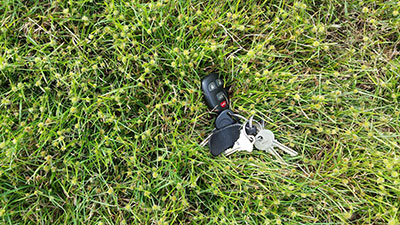False-green kyllinga control in cool-season turf

A dense mat of false-green kyllinga with seedheads.
False-green kyllinga (Kyllinga gracillima) has become increasingly problematic in the Mid-Atlantic and Northeast. False-green kyllinga is related to yellow nutsedge (Cyperus esculentus), and both species have a triangular stem. Yellow nutsedge typically is interspersed within the turfgrass canopy, while false-green kyllinga tends to form a dense perennial stoloniferous/rhizomatous mat that appears similar to turfgrass. False-green kyllinga produces a round, green seedhead beginning in mid-July. It tends to thrive in fairways and has been found in putting greens.
Field research in 2015 examined single and sequential applications of Sedgehammer (halosulfuron-methyl, Gowan, others), Celero (imazosulfuron, Nufarm) and Dismiss (sulfentrazone, FMC) at labeled rates. Treatments were applied on June 11 and sequential applications were made four weeks later. All treatments provided acceptable control four weeks after application. When evaluated four months after treatment, a single application of Sedgehammer (1.33 oz./A) and Celero (14 oz./A) provided 30-percent and 95-percent control, respectively. Two Sedgehammer applications on a 4-week interval provided greater than 95-percent control. Control from single or sequential applications of various Dismiss programs (4 to 8 fl. oz./A) provided control shortly after application but provided no control by October.
This research demonstrates that halosulfuron-methyl and imazosulfuron are effective products for control, but at least two applications on 4-week intervals are necessary. Include a non-ionic surfactant with imazosulfuron and most halosulfuron-methyl products.
For severe infestations, multiple applications across multiple years are required for control. While our research demonstrates that sulfentrazone is less effective, it should be part of a rotation to prevent herbicide resistance. Halosulfuron-methyl and imazosulfuron have the same mode of action (ALS inhibition), and relying solely on these products makes likely selection of an ALS-resistant biotype. It’s prudent for resistance management that programs use halosulfuron-methyl or imazosulfuron one year and sulfentrazone the next year.
Matt Elmore, Ph.D., is an assistant Extension specialist in weed science at Rutgers University, and James Murphy, Ph.D., is an Extension specialist in turfgrass management at Rutgers. You may reach Matt Elmore at matthew.elmore@rutgers.edu for more information.
Photo: Jim Murphy









